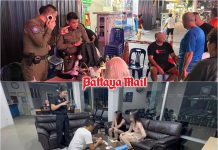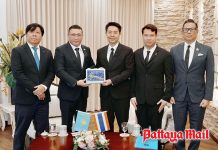From amphibious landings to sniper training to tips on flying one of the oldest warplanes still in the air, Thailand’s naval forces gained more useful insight into modern warfare from the U.S. Navy in the two nations’ 17th Cooperation Afloat Readiness and Training exercise.
Vice Adm. Surachai Sangkapong, commander of the Royal Thai Fleet, Rear Adm. Chaiyot Sunthornnak, commander of Frigate Squadron 2 and Tomas F. Carney, director of the U.S. CARAT forces, brought the nine-day war games to a close in Sattahip May 20.
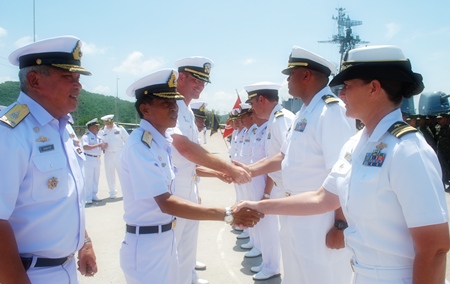 Royal Thai Navy Vice Adm. Surachai Sungkhapong greets U.S. Navy officers during the CARAT 2011 closing ceremony.
Royal Thai Navy Vice Adm. Surachai Sungkhapong greets U.S. Navy officers during the CARAT 2011 closing ceremony.
The two sides engaged in more than 1,500 training and cultural-exchange exercises with the U.S. sending four ships and 3,500 men to participate.
Shore-based activities included engineering and damage control training exchanges, joint medical, dental and civic action projects, and joint community service projects at local schools. The at-sea phase focused on developing maritime security capabilities in areas such as maritime interdiction, information sharing, combined operations at sea, patrols and gunnery exercises, and anti-piracy and anti-smuggling exercises.
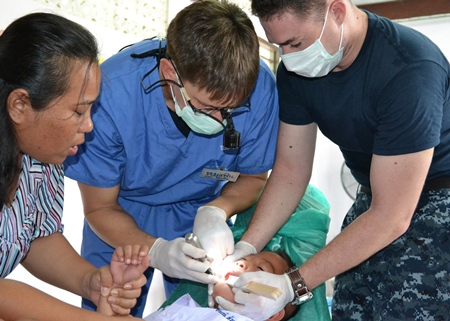 Ban Chang (May 12, 2011) – Hospital Corpsman 2nd Class Jared Myers (right), attached to Commander Task Force 73, Singapore, assists Lt. Michael Syamken, attached to USS Tortuga (LSD 46), extract an infected tooth from a young Thai dental patient during the Medical Civic Action Program (MEDCAP) at the Somboon Ranaram School. (U.S. Navy photo by Mass Communication Specialist 1st Class Jose Lopez, Jr.)
Ban Chang (May 12, 2011) – Hospital Corpsman 2nd Class Jared Myers (right), attached to Commander Task Force 73, Singapore, assists Lt. Michael Syamken, attached to USS Tortuga (LSD 46), extract an infected tooth from a young Thai dental patient during the Medical Civic Action Program (MEDCAP) at the Somboon Ranaram School. (U.S. Navy photo by Mass Communication Specialist 1st Class Jose Lopez, Jr.)
Top officers from both sides stressed CARAT is a change to create closer ties, both personally and operationally, between Thai and U.S. navies. That was born out by several of the exercises.
Early in the operation, U.S. marine snipers with Landing Force Company instructed Royal Thai Marines on applying the fundamentals of marksmanship to sniper tactics. American instructors discussed windage, trigger control, breathing control and how to effectively work as a sniper team.
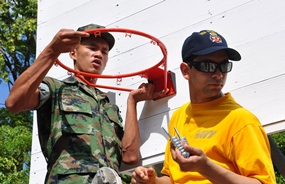 Ban Chang (May 12, 2011)- Fireman Giovanni Santiago, of USS Tortuga (LSD 46), waits for tools while he and a Royal Thai marine hang a basketball goal at the Wat Sombonaro School. USS Tortuga, USS Ruben James (DDG 57) and USS Howard (DDG 83) sent more than 30 Sailors to the school to help preserve a bathroom and refurbish a playground as a community service project for CARAT Thailand 2011. (U.S. Navy photo by Lt. K. Madison Carter)
Ban Chang (May 12, 2011)- Fireman Giovanni Santiago, of USS Tortuga (LSD 46), waits for tools while he and a Royal Thai marine hang a basketball goal at the Wat Sombonaro School. USS Tortuga, USS Ruben James (DDG 57) and USS Howard (DDG 83) sent more than 30 Sailors to the school to help preserve a bathroom and refurbish a playground as a community service project for CARAT Thailand 2011. (U.S. Navy photo by Lt. K. Madison Carter)
“The training is very good. It helps me to have more knowledge,” said PFC 1st Class Chaiyoot Moonthongchoon told the media. “I got to train on different equipment and learn more techniques.”
Other U.S. instructors schooled Thai naval aviators on best practices when flying and maintaining the P3-C Orion, a Vietnam-era plane still in use by Thai forces. The U.S. brought over one of its old planes to have instructors provide Thai forces information on maintenance, operations, mine-laying and search-and-rescue procedures.
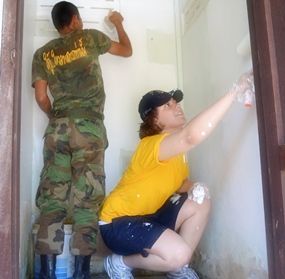 Ban Chang (May 12, 2011) – Operations Specialist Seaman Laura Jackson, attached to USS Tortuga (LSD 46), and a Royal Thai navy sailor, paint the inside of a bathroom at the Somboon Ranaram School during a joint community service project. (U.S. Navy photo by Mass Communication Specialist 1st Class Jose Lopez, Jr.)
Ban Chang (May 12, 2011) – Operations Specialist Seaman Laura Jackson, attached to USS Tortuga (LSD 46), and a Royal Thai navy sailor, paint the inside of a bathroom at the Somboon Ranaram School during a joint community service project. (U.S. Navy photo by Mass Communication Specialist 1st Class Jose Lopez, Jr.)
“The Thai Navy flies the P-3, so there was a lot of commonality already in our work and procedures,” Lt. Cmdr. Kim DaCosta said in a U.S. 7th Fleet statement. “The Thai aircrews integrated well with our aircrews, and that’s exactly what this exercise is all about – becoming familiar with one another so when we are called to work together, there’s a baseline of understanding and trust already there.”
As is customary in recent years, CARAT wrapped with a joint amphibious landing at Had Yao Beach. The exercise was a beach assault using amphibious assault vehicles. U.S. and Thai forces each had an objective on the beach to seize.
It was an operation that was beneficial for both Thais and Americans, as many young U.S. Marines have never experienced a full amphibious assault.
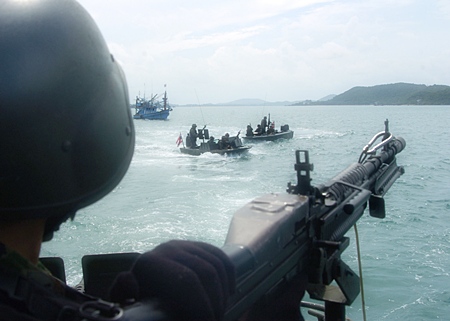 A Royal Thai Navy sailor monitors a target during a riverine exercise in the Sattahip Harbor Basin. (U.S. Navy photo by Mass Communication Specialist 3rd Class Christopher S. Johnson)
A Royal Thai Navy sailor monitors a target during a riverine exercise in the Sattahip Harbor Basin. (U.S. Navy photo by Mass Communication Specialist 3rd Class Christopher S. Johnson)
“There is an entire generation of Marines that lack the amphibious assault experience,” Capt. Rudy Cazares, company commander for Landing Force Company, told the press. “This evolution afforded them the opportunity to get that training.”
The exercise included nine amphibious-assault vehicles from the U.S. and six from Thailand. A company of Thai Marines and a company of U.S. Marines disembarked the AAVs and assaulted their respective objectives.
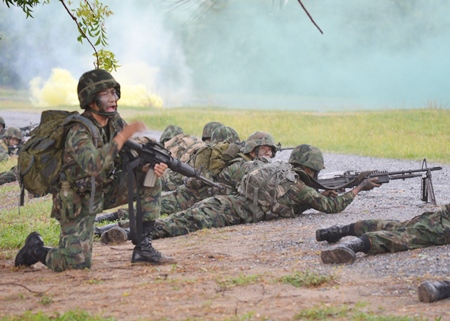 A Royal Thai Marine shouts orders to his troops as they land ashore during an amphibious assault evolution of CARAT Thailand 2011. (U.S. Navy photo by Mass Communication Specialist 1st Class Jose Lopez, Jr.)
A Royal Thai Marine shouts orders to his troops as they land ashore during an amphibious assault evolution of CARAT Thailand 2011. (U.S. Navy photo by Mass Communication Specialist 1st Class Jose Lopez, Jr.)
While the amphibious assault was the culminating event, U.S. and Thai service members conducted extensive training in jungle survival, combat marksmanship, military operations in urban terrain, combat lifesaving skills, martial arts and sniper training.
“Despite the language barrier and the use of different equipment, I can confidently say it was a positive experience across the board,” Cazares said. “We gained just as much from this experience from the Thai as they did from us.”
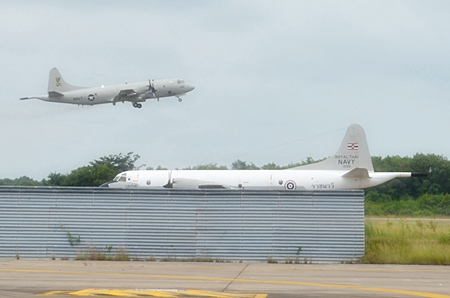 U-Tapao – An P-3C Orion assigned to Patrol Squadron (VP) 4 takes off as a Royal Thai Navy P-3C taxis down the runway to join it during a combined mine laying exercise. (U.S. Navy photo by Mass Communication Specialist 1st Class Jose Lopez, Jr.)
U-Tapao – An P-3C Orion assigned to Patrol Squadron (VP) 4 takes off as a Royal Thai Navy P-3C taxis down the runway to join it during a combined mine laying exercise. (U.S. Navy photo by Mass Communication Specialist 1st Class Jose Lopez, Jr.)



